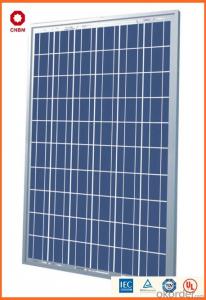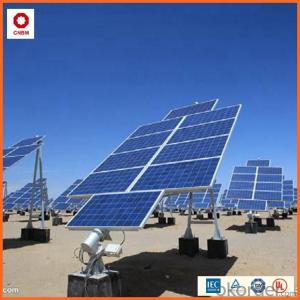Solar Energy Systems San Diego - Stock 305W Poly Solar Panel 0.46/W A Grade Good Solar Panel On Sale
- Loading Port:
- China main port
- Payment Terms:
- TT OR LC
- Min Order Qty:
- 1 watt
- Supply Capability:
- 10000000 watt/month
OKorder Service Pledge
OKorder Financial Service
You Might Also Like
Specification
Hot Sale !!! Quality and Safety of 245w-320w Poly Solar Panel
1. Rigorous quality control meets the highest international standards.
2. High-transmissivity low-iron tempered glass, strong aluminium frame.
3. Using UV-resistant silicon.
4. IS09001/14001/CE/TUV/UL
Warranties of 245w-320w Poly Solar Panel
1. 10 years limited product warranty
2. 15 years at 90% of the minimal rated power output
3. 25 years at 80% of the minimal rated power output
Technical date of 245w-320w Poly Solar Panel
Specification
Characteristics of Poly solar panels CNBM (245-320W) | |||||
Max Power Voltage Vmp(V) | 30.3 | 30.8 | 31.1 | 31.4 | 31.85 |
Max Power Current Imp(A) | 7.60 | 7.64 | 7.73 | 7.81 | 7.85 |
Open Circuit Voltage Voc(V) | 36.1 | 36.6 | 37 | 37.3 | 37.68 |
Short Circuit Current Isc(A) | 8.50 | 8.55 | 8.65 | 8.75 | 8.85 |
Max Power Pm(W) | 230W | 235W | 240W | 245W | 250W |
Temperature Coefficient of Cells Poly solar panels CNBM (245-320W) | |
NOCT | 45 ± 2 |
Temperature Coeffucients of Isc | 0.0492 |
Temperature Coeffucients of Voc ( | -0.3374 |
Temperature Coeffucients of Voc | -0.4677 |
Mechanical Data of Poly solar panels CNBM (245-320W) | |
Dimension | 1638 × 982 × 40 mm |
Weight | 19.5 kg |
No. of Cells and Connections | 60 (6 ×10) |
Tolerance | 0 ~ + 5 W |
Cell | Monocrystalline Cell 156 × 156 mm |
Packing | 624 Pcs/40ft(H) Container |
Limits of Poly solar panels CNBM (245-320W) | |
Operating Temperature | -4 0to +85 |
Storage Temperature | -40to +85 |
Max System Voltage | 1000VDC(IEC) / 600VDC(UL) |
Features of our products:
• High conversion efficiency mono/poly-crystalline amorphous silicon solar cells
• Modules incorporate high performance bypass diodes to minimize the power drop caused by shading
• High transmittance, low-iron tempered glass
• High performance EVA encapsulant to prevent destroying and water.
• AI frame: without screw, corner connection. 8 holes on the frame can be installed easily
• Good performance of preventing from atrocious weather such as wind and hails
• Certifications: CE IEC TUV VDE UL, Class I
• 10 years 90% power output warranty

- Q: Are there any noise concerns associated with solar energy systems?
- Noise concerns may arise when using solar energy systems, though they are generally quiet. One of the main sources of noise is the inverter, which converts DC electricity from the panels into AC electricity for use. The inverter may emit a low humming noise, similar to that of a fridge or AC unit. However, the noise level is typically very low and not considered disruptive. Fortunately, advancements in technology have led to the development of quieter inverters that produce minimal noise. Some inverters have noise reduction features like soundproof enclosures or low-noise fans. Additionally, the location of the inverter can help minimize noise concerns. Placing it in a well-insulated area, away from living spaces, can further reduce potential noise disturbances. It's important to note that other components of a solar energy system, such as mounting structures and wiring, do not generate significant noise. Solar panels themselves are noiseless as they rely on sunlight for electricity generation, without any moving parts. In conclusion, while certain components of solar energy systems may have noise concerns, advancements in technology and proper installation practices have greatly reduced potential disruptions.
- Q: What maintenance is required for a solar energy system?
- Regular maintenance is required for a solar energy system to ensure optimal performance. This includes cleaning the solar panels, checking for any debris or shading that could affect their efficiency, inspecting the electrical components for any damage or loose connections, and monitoring the system's performance through regular data analysis. Additionally, it is necessary to maintain and replace the batteries (if present) and conduct routine inspections to identify and address any potential issues.
- Q: How does the efficiency of solar panels vary across different installation orientations?
- The efficiency of solar panels can vary across different installation orientations due to factors such as the angle and direction of sunlight, shading, and temperature. Panels that are installed at the optimal angle and direction towards the sun, typically facing south, tend to have higher efficiency as they receive maximum sunlight throughout the day. However, panels installed at other orientations can still generate significant electricity depending on their exposure to sunlight.
- Q: Can solar energy systems be used for powering restaurants?
- Yes, solar energy systems can be used for powering restaurants. Solar panels can be installed on the roof or in an open area near the restaurant to capture sunlight and convert it into electricity. This renewable energy source can help reduce electricity costs and lower the carbon footprint of the restaurant.
- Q: Can solar energy systems be used for powering off-grid eco-resorts?
- Yes, solar energy systems can definitely be used for powering off-grid eco-resorts. Solar panels can be installed on the roofs or in open areas of the resorts to harness sunlight and convert it into electricity. This renewable energy source can provide a sustainable and reliable power supply, allowing eco-resorts to operate independently from the grid. Additionally, solar energy systems can help reduce carbon emissions and promote eco-friendly practices in the hospitality industry.
- Q: How do solar energy systems affect water quality?
- Solar energy systems do not directly affect water quality as they do not release any pollutants or contaminants. However, the manufacturing and disposal of solar panels may have some environmental impact, including the potential for water pollution if not managed properly.
- Q: Can solar energy systems be used in areas prone to hurricanes or tornadoes?
- Yes, solar energy systems can be used in areas prone to hurricanes or tornadoes. However, special considerations need to be taken to ensure the durability and resilience of the system. This includes using stronger mounting structures, reinforced frames, and impact-resistant materials. Additionally, regular maintenance and inspection are crucial to identify and address any potential damages caused by severe weather events.
- Q: Are there any risks of electrical malfunction or failure with solar energy systems?
- Solar energy systems come with certain risks of electrical malfunction or failure. One of the primary concerns revolves around faulty or damaged electrical connections, which can cause a loss of power generation or even spark electrical fires. Moreover, extreme weather conditions like lightning strikes or strong winds have the potential to harm solar panels or inverters, resulting in either temporary or permanent system failure. Another issue lies in the gradual degradation of solar panels over time, leading to reduced efficiency and eventual replacement. Furthermore, inadequate installation or maintenance practices may contribute to system failure or electrical malfunctions. To mitigate these risks, it is crucial to have solar energy systems installed by qualified professionals and ensure regular inspections and maintenance are conducted.
- Q: How long does it take to install a solar energy system?
- The time it takes to install a solar energy system can vary depending on factors such as the size of the system, complexity of the installation, and the availability of equipment and manpower. However, on average, a typical residential solar panel installation can take anywhere from one to three days.
- Q: How do solar energy systems impact the local community?
- Solar energy systems have a positive impact on the local community in several ways. Firstly, they reduce reliance on fossil fuels, which helps to combat climate change and improve air quality. Solar energy systems also create job opportunities and stimulate economic growth by attracting investments in renewable energy. Moreover, they can lower energy costs for residents and businesses, making electricity more affordable. Lastly, solar power installations contribute to a sense of community pride and environmental stewardship, inspiring others to adopt sustainable practices.
Send your message to us
Solar Energy Systems San Diego - Stock 305W Poly Solar Panel 0.46/W A Grade Good Solar Panel On Sale
- Loading Port:
- China main port
- Payment Terms:
- TT OR LC
- Min Order Qty:
- 1 watt
- Supply Capability:
- 10000000 watt/month
OKorder Service Pledge
OKorder Financial Service
Similar products
Hot products
Hot Searches
Related keywords































